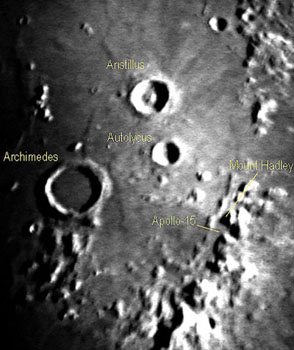

Left.- The photo on the left shows the eastern shore of Mare Imbrium, located in the
northwest part of the close-side of the moon. The craters Archimedes (the big one, south
of other two), Aristillus (North) and Autolycus occupy the center of the picture. The
north part of the Appennine mountains can be seen east of Archimedes, this is an
interesting feature as this was the site of Apollo 15 "landing". View was photographed from the author's backyard with a Meade
LX-90 20 cm Schmidt-Cassegrain reflector telecope (f/10).
Right.- NASA Photo ID: S71-44667 File Name: 10075716.jpg Film
Type: 4x5 BW Date Taken: 08/25/71 Title: View of Hadley-Apennine area, looking north,
photographed by Apollo 15 Description: An oblique view of the Hadley-Apennine area,
looking north, as photographed by the Fairchild metric camera in the SIM bay of the Apollo
15 Command/Service Module in lunar orbit. Hadley Rille meanders through the lower center
of the picture. The Apennine Mountains are at lower right. The Apollo 15 Lunar Module
touchdown point is on the east side of the "chicken beak" of Hadley Rille. The
Caucasus Mountains are at upper right. The dark mare area at the extreme upper right is a
portion of the Sea of Serenity. The Marsh of Decay is at lower left. The large crater near
the horizon is Aristillus, which is about 55 kilometers (34.18 statute miles) in diameter.
The crater just to the south of Aristillus is Autolycus, which is about 40 kilometers (35
statute miles) in diameter. The crater Cassini is barely visible on the horizon at upper
right.
Apollo-15,
NASA site
� Copyright 1983 - 2001 by
Antonio Fern�ndez unless otherwise noted. All rights reserved. Contents of these pages,
including photos and text, may not be reproduced, published, copied or transmitted in any
form without written permission of the author.